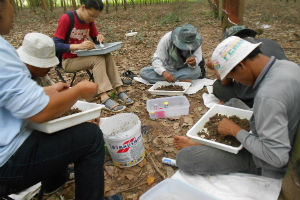 Effect of rubber tree plantations on soil biodiversity
Effect of rubber tree plantations on soil biodiversity
Forest plantations are either denigrated or praised because of their effect on the environment without any solid evidence from scientific studies to support the arguments put forward by those who are in favour of or opposed to them.
This issue remains open to discussion in the literature. Some authors claim that commercial plantations have a positive action in rehabilitating degraded soils and in carbon sequestration. Others take the opposite stand point, claiming that there is a high risk of loss of fertility and biological and functional diversity in the soils.
Very few studies have been undertaken to determine the impact of tree plantations on biodiversity, in particular soil biodiversity. One of the few studies carried in the Ivory Coast on rubber plantations of different ages indicates that the diversity and density of the soil fauna vary depending on the age of the plantation and that they drop significantly after 30 years, when the trees are much less productive. Is there a cause and effect relationship? No equivalent study has been undertaken for the microbial community despite the important role they play in soil fertility
This project targets 3 functional groups within the soil :
- Biochemical engineers: these are mainly the bacteria and fungi responsible for more than 90% of organic matter decomposition processes.
- Biological regulators: these are the predators of the microorganisms which regulate their dynamics. The target group is the nematodes which is currently one of the best biological indicators of soil status.
- Biosystem engineers (earthworms, ants and termites): these regulate the availability of resources for the other soil organisms.
Aims
Develop environmental impact indicators that could be applied, in particular for life cycle measurements in other fields
The specific aims are:
- Determine the impact of rubber plantations on soil biodiversity and carbon sequestration with respect to the cropping systems they replace
- Characterise the most appropriate indicators of the diversity and the services provided by the soils for measurements throughout the life cycle of rubber plantations
Date
2013-2016
Partners
- LDD (land Dept. Development)
- Université de Kasetsart
- Université de Khon Kaen
Funding
Institut Français du Caoutchouc (IFC) et les sociétés SIPH, SOCFIN et MICHELIN
Contact
Alain Brauman, Eco&Sols, IRD Thaïlande
e-mail :






